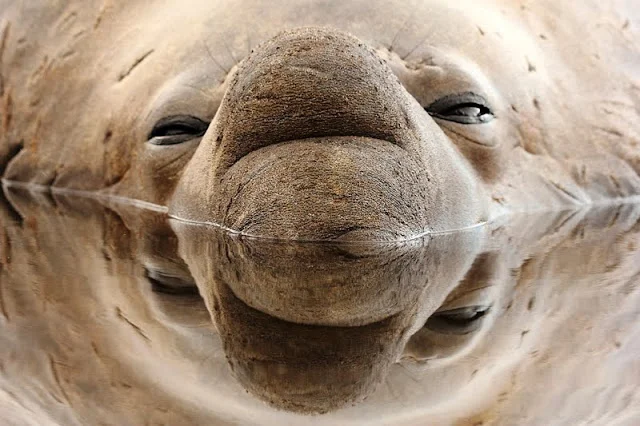In February I decided to try my luck and I entered a few images into the prestigious Veolia Wildlife Photographer of the Year competition. I didn't expect much as the standard is very high, with professional photographers usually taking top honours. This year they received over 48,000 images from 98 countries so I was very surprised when I found out that three of mine had made it through to the final round of judging in May. Stoked!
The images that were selected aren't necessarily my favourites and this just highlights how subjective photography is. What constitutes a great image to one person is not necessarily a great image to another. That is probably the most beautiful thing about photography.
Here are my three images that made it through:
Category:
Creative visions
'This category is for conceptual pictures – original and surprising views of nature, whether figurative or abstract – which are judged purely on their artistic merits.'
Reflections of the Past and Present

Macaroni penguins
Eudyptes chrysolophus
are the largest avian consumers of marine resources in the Southern Ocean, but very often they themselves become the consumed. Life for a sub-Antarctic penguin is harsh. In the water they risk ending up in the menacing jaws of killer whales and fur seals, and on land they’re constantly harassed by skuas and giant petrels that rob them of their eggs and chicks and prey on the weak. As a researcher on Marion Island I got used to death really quickly because it was all around me; that’s just how the natural world revolves. Penguin colonies are littered with bones and many macaroni penguins even use them to build their nests. I tried to photograph the close relationship that macaroni penguins share with the dead but it always turned out too gruesome. I wanted to show it in a beautiful and subtle way.
The opportunity came on a wind-still and moody-skied day when I was walking along the edge of a colony and saw the reflections of passing penguins in a pond of bones; I knew it was perfect. The light was bad so I cranked up the ISO and narrowed the aperture to get a nice sharpness throughout the image. The macaronis stopped and stared at me across the pond scattered with the bony remnants of their past relatives. They soon gave up trying to figure me out and carried on up to their nests, most probably made up of some more bony remnants of past relatives.
Canon 550D + Sigma 18-200mm f/3.5-6.3 @ 1/80 sec, f/18, ISO 800
Category:
Animals in their environment
'Images must convey a feeling of the relationship between an animal and the place where it lives, and have a great sense of atmosphere.'
The Amphitheatre

Marion Island is home to more than 250,000 breeding pairs of macaroni penguins, nearly 13,000 of which spend the summer months building nests, mating, incubating eggs and raising chicks on a terraced landscape on the South-west coast called The Amphitheatre. It’s quite a sight to see the winding terraces, jam-packed with penguins, spiralling up to a point some 70 metres above the beach where they haul out. The acoustics are also fantastic! I’ll leave it up to your imagination to dream up what kind of sound emanates from thousands of buzzing macaroni penguins gathered in The Amphitheatre. Such a spectacle!
Canon 550D + Sigma 18-200mm f/3.5-6.3 @ 1/200 sec, f/11, ISO 400
Category:
Animal Portraits
'A good portrait reveals something about its subject beyond the obvious. Images may be either close-up or mid-range and should convey a sense of intimacy, personality and spirit – the very essence of the animal – in a fresh and imaginative way.'
The Rebreather

Southern elephant seal bulls
Mirounga leonina
are notorious for their violent battles, roaring burps and large, elephant-like proboscises. In a species that is one of the most sexually dimorphic animals on the planet, it is this proboscis and their large body size which distinguishes the bulls from the females. The proboscis amplifies the sound of burps used to intimidate other bulls, as well as functioning as a sort of rebreather, reabsorbing moisture from the animals’ exhalations via specialised cavities. This reabsorption is important during the mating season when a bull needs to retain body moisture as he doesn’t leave the beach for an entire three months due to the constant threat of other bulls sneaking ashore and mating with his females.
The elephant seal bull photographed here was taking some time out in a rock pool when a friend and I stumbled upon him. The water was a perfect mirror and it looked so dreamy that we whipped out our cameras. His eyes then opened and he exhaled, shattering the mirror's surface with bubbling splashes and ricocheting ripples. He took a breath in and then under the water his trunk went. His eyes closed and his reflection in the water gradually returned. We took turns photographing him from a low perspective as he repeated his cycle, unfazed by our presence; breathe in, close eyes, sleep, open eyes, breathe out. We got our pictures, but one can't help but wonder why he didn't just sleep with his head on a nearby rock out of the water? Conserving body moisture I suppose.
Canon 550D + Canon 100mm f/2.8 @ 1/320 sec, f/4, ISO 200
Winners and highly commended images will be announced in mid-May. Check out the insane images from last year at the Natural History Museum's
.
